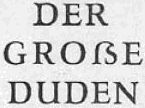Capital ẞ
Capital sharp S (ẞ; German: großes Eszett) is the majuscule (uppercase) form of the eszett (also called scharfes S, 'sharp s') ligature in German orthography (ß). German eszett is, in origin, a ligature of two minuscule (lowercase) letters, long s and tailed z, and as such has no traditional majuscule form. Nevertheless, typefaces used for printing German language texts during the early 20th century often included capital eszett glyphs. There were repeated calls to include capital eszett in official German orthography, particularly in the early 20th century, and again during the 1950s and 1960s in East Germany, but the character did not enter widespread use or become part of official orthography until 2017.

The grapheme was introduced as part of the Latin Extended Additional block in Unicode version 5.1 in 2008 (U+1E9E ẞ LATIN CAPITAL LETTER SHARP S). This led to renewed debate regarding the graphical design of the character for the purposes of Unicode typefaces.
History
Historical typefaces offering a capitalized eszett mostly date to the time between 1905 and 1930. The first known typefaces to include capital eszett were produced by the Schelter & Giesecke foundry in Leipzig, in 1905/06. Schelter & Giesecke at the time widely advocated the use of this type, but its use remained very limited.
At the height of the Antiqua–Fraktur dispute, in 1909, Fritz Helmuth Ehmcke designed an Antiqua font intended to preserve the advantages of Fraktur for the purposes of typesetting German without resorting to a bastardization of the two traditions. The resulting Ehmcke-Antiqua was unique in not only offering a capital variant of ß, but also a capital variant of long s (ſ) as well as capital ligatures of the ch and ck digraphs. Ehmcke-Antiqua was adopted by Stephenson Blake under the name Carlton, which was adapted (without the specialised ligatures offered by Ehmcke's original font) in digital form by Linotype in 1994. Most type designers attempted to fit the shape of the ß ligature into their majuscules. An alternative approach was a type design which derived the majuscule equivalent of ß from a ligature of the majuscule digraph SZ. An example of this is the Cicero specimen published by Bauer Type Foundry c. 1912, which included both majuscule SS and SZ ligatures.[1]

The preface to the 1925 edition of the Duden dictionary expressed the desirability of a separate glyph for capital ß:
Die Verwendung zweier Buchstaben für einen Laut ist nur ein Notbehelf, der aufhören muss, sobald ein geeigneter Druckbuchstabe für das große ß geschaffen ist.[2]
The use of two letters for a single phoneme is makeshift, to be abandoned as soon as a suitable type for the capital ß has been developed.
The Duden was edited separately in East and West Germany during the 1950s to 1980s. The East German Duden of 1957 (15th ed.) introduced a capital ß in its typesetting without revising the rule for capitalisation. The 16th edition of 1969 still announced that an uppercase ß was in development and would be introduced in the future. The 1984 edition again removed this announcement and simply stated that there is no capital version of ß.[3]
In the 2000s, there were renewed efforts on the part of certain typographers to introduce capital ẞ.[4] A proposal to include a corresponding character in the Unicode set submitted in 2004 was rejected.[5] A second proposal submitted in 2007 was successful, and the character was included in Unicode version 5.1.0 in April 2008 (U+1E9E ẞ LATIN CAPITAL LETTER SHARP S).[6] The international standard associated with Unicode (UCS), ISO/IEC 10646, was updated to reflect the addition on 24 June 2008. In August of the same year, Duden (Bibliographisches Institut, duden.de) published a comment regarding capital eszett (Das große Eszett) in its Newsletter. In the statement, the introduction of capital ẞ by ISO 10646 is welcomed as an "important innovation, especially for publishing houses, albeit not part of official orthography".[7]
The 5th edition of the German "Toponymic Guidelines for map and other editors for international use" (2010) makes explicit mention of the recognition of capital ẞ by DIN and ISO and its adoption in the Unicode character set.[8]
In 2016, the Council for German Orthography proposed the introduction of optional use of ẞ in its ruleset (i.e. variants STRASSE vs. STRAẞE would be accepted as equally valid).[9] The rule was officially adopted in 2017.[10]
Current situation

The capital ẞ did not form part of official German orthography until June 2017. Its inclusion in ISO 10646 in 2008 revived the century-old debate among font designers as to how such a character should be represented.
There are two basic approaches: on one hand, the character may be designed as a capital version of lowercase ß; on the other, it may be derived from a ligature of uppercase letters SS or SZ. Designs for an SZ ligature has been part of typesets from the 1910s until the 1950s, but in the opinion of Herrmann (2011), the long-standing alphabetic equivalence of ß with ss and the abolition of the optional capitalization of ß as SZ (abandoned in 1996[11]) means that this is no longer a valid option that "Germans would want to use on a regular basis".
At the same time, Herrmann also rejects the realization of capital ß as an SS ligature, because "The whole point of having ß in the German alphabet today, is that it represents a different pronunciation [namely, of the length of the preceding vowel] than ss", concluding that the "capitalized ß" approach is "the most promising one", and indeed the one followed by most font designers since 2008.[12]
The main difference in the shapes of ẞ in contemporary fonts is the depiction with a diagonal straight line vs. a curved line in its upper right part, reminiscent of the ligature of tailed z or of round s, respectively. The code chart published by the Unicode Consortium favours the former possibility,[13] which has been adopted by Unicode capable fonts including Arial, Calibri, Cambria, Courier New, Dejavu Serif, Liberation Sans, Liberation Mono, Linux Libertine and Times New Roman; the second possibility is more rare, adopted by Dejavu Sans. Some fonts adopt a third possibility in representing ẞ following the Sulzbacher form of ß, reminiscent of the Greek beta (β); such a shape has been adopted by FreeSans and FreeSerif, Liberation Serif and Verdana.[14]
References
- Alphabete und Ornamente für Skizzierzwecke, Bauersche Gießerei, Typographische Vereinigung Leipzig, c. 1912.
- Vorbemerkungen, XII. In: Duden – Rechtschreibung. 9. Auflage, 1925
- Der Große Duden. 25. Auflage, Leipzig 1984, S. 601, K 41.
- Signa – Beiträge zur Signographie. SonderHeft 9, 2006, online
- Andreas Stötzner. "Proposal to encode Latin Capital Letter Double S (rejected)" (PDF). Retrieved 2014-01-30.
- "DIN_29.1_SCHARF_S_1.3_E" (PDF). Retrieved 2014-01-30. "Unicode chart" (PDF). Retrieved 2014-01-30.
- "Die internationale Organisation für Normung (ISO) hat nun – in den internationalen Zeichensätzen ISO-10646 und Unicode 5.1 – ein Zeichen für das große Eszett festgeschrieben: eine wichtige Neuerung, besonders für Buch- und Zeitungsverlage, aber eine, die nicht Bestandteil der amtlichen Rechtschreibung ist. Allerdings darf mündigen Bürgerinnen und Bürgern im Einzelfall getrost die Entscheidung überlassen werden, ob sie das große Eszett etwa für die Schreibung ihres Namens nutzen oder nicht." Das große Eszett (duden.de), Newsletter of 22 August 2008.
- Siever, Jörn (2010). "1.1.3 Sonderbuchstabe ß ß". Standiger Ausschuss fur geographische Namen (StAGN) Empfehlungen und Hinweise für die Schreibweise geographischer Namen für Herausgeber von Kartenwerken und anderen Veröffentlichungen für den internationalen Gebrauch [Toponymic Guidelines for map and other editors for international use] (PDF) (Report) (5. überarbeitete Ausgabe [Fifth revised] ed.). Frankfurt: Geschäftsstelle des StAGN im Bundesamt für Kartographie und Geodäsie. Archived from the original (PDF) on 2015-12-27.
- 3. Bericht des Rats für deutsche Rechtschreibung 2011–2016 (2016), p. 7.
- "Deutsche Rechtschreibung Regeln und Wörterverzeichnis: Aktualisierte Fassung des amtlichen Regelwerks entsprechend den Empfehlungen des Rats für deutsche Rechtschreibung 2016" (PDF). §25, E3. Archived from the original (PDF) on 2017-07-06. Retrieved 29 June 2017.
E3: Bei Schreibung mit Großbuchstaben schreibt man SS. Daneben ist auch die Verwendung des Großbuchstabens ẞ möglich. Beispiel: Straße – STRASSE – STRAẞE. [When writing in all caps, one writes SS. It is also permitted to write ẞ. Example: Straße – STRASSE – STRAẞE.]
- until 1996, it was recommended to render ß as SS in allcaps except when there was ambiguity, in which case it should be rendered as SZ. The common example for such a case was IN MASZEN (in Maßen "in moderate amounts") vs. IN MASSEN (in Massen "in massive amounts"), where the difference between the spelling in ß vs. ss could actually reverse the conveyed meaning.
- Ralf Herrmann, "How to draw a Capital Sharp S", 2 August 2011
- Latin Extended Additional
- LATIN CAPITAL LETTER SHARP S (U+1E9E) Font Support (fileformat.info)
- "Das große Eszett.", Signa, Heft Nr. 9. Edition Waechterpappel, Grimma 2006 ISBN 3-933629-17-9.
- Otto Schwarzer: "Für ein großes SZ", Sprachreport 2, Institut für deutsche Sprache (1993), pp. 11–13.
External links
| Look up ẞ in Wiktionary, the free dictionary. |
| Wikimedia Commons has media related to Capital sharp s. |
- Ralf Herrmann, Versal-Eszett (ẞ), typografie.info, 18 February 2013 (in German).
- Christoph Koeberlin, The German Capital Letter Eszett, Typefacts, 4 July 2017.